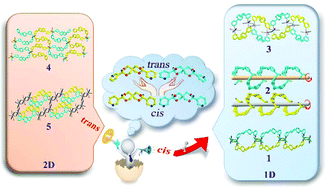Five complexes based on a new racemic tetraoxaspiro ligand: correlation of potential coordination preferences with the structure, magnetic properties and luminescence properties†
Abstract
A new ligand, rac-(R,S)-3,9-bis(pyridin-3-yl)-2,4,8,10-tetraoxaspiro[5.5]undecane ((R,S)-bptu), is synthesized, and five novel complexes, namely, {[Cu[(R,S)-bptu]Cl2]·0.5NMP}n (1), {[Zn[(R,S)-bptu]Cl2]·CH3CN}n (2), {Cd2[(R,S)-bptu]2Cl4(NMP)2}n (3), {[Cd[(R,S)-bptu]2Cl2]·2CH3CN}n (4), and {Cd3[(R,S)-bptu]2Cl6(DMF)2}n (5), (NMP = N-methyl-2-pyrrolidone, DMF = N,N-dimethylformamide), are obtained via a layered diffusional reaction. (R,S)-bptu and complexes 1–5 are characterized by single-crystal X-ray diffraction, element analyses, powder X-ray diffraction (PXRD), and Fourier transform infrared spectroscopy (FTIR) and thermogravimetric analyses (TGA). Complexes 1–3 show three different 1D structures: 1 is a mesomeric looped chain, 2 is a racemic helix compound, and 3 is a mesomeric zigzag chain, while 4 and 5 are two different mesomeric 2D structures, of which 4 is a 2D wave-like layer and 5 is a 2D cellular layer. Structural diversity indicates that the coordination preferences (cis- and trans-configurations) of (R,S)-bptu play a leading role in the self-assembly of complexes: cis-bptu tends to form one-dimensional structures 1–3, while trans-bptu is easier to construct higher dimensional structures 4–5. Secondly, the different transition metal atom M(II) adopts diverse geometry in 1–5: Cu(II) adopts square pyramidal geometry in 1, Zn(II) employs a tetrahedron configuration in 2, and especially in 3–5, Cd(II) displays a trigonal bipyramidal configuration, cis-cis–trans, cis and trans octahedral configuration. Finally, the different solvent system, the coordinated/free solvent, and the secondary building units (SBUs) affect the diversification of the structure. A variable temperature magnetic susceptibility investigation manifests that antiferromagnetic interactions exist between the neighbouring metal ions in 1. Furthermore, the luminescence properties of 2–5 are investigated in the solid state at room temperature, and 4 shows highly selective and sensitive sensing for Fe3+ ions.



 Please wait while we load your content...
Please wait while we load your content...